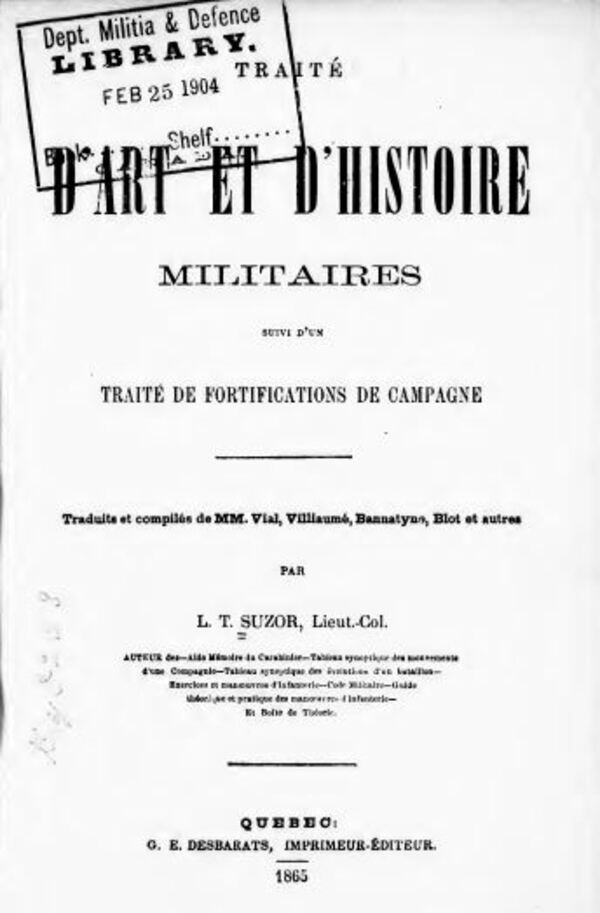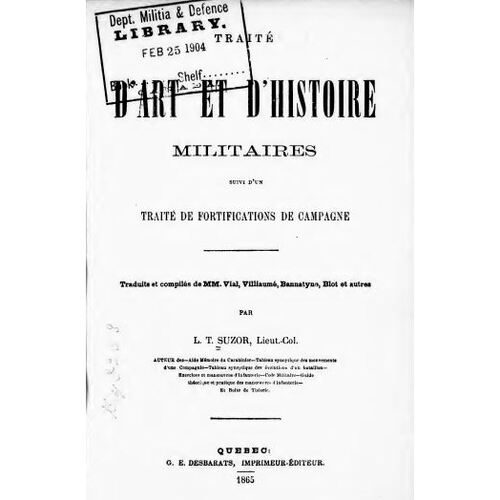
Source: Link
SUZOR, LOUIS-TIMOTHÉE, soldier and author; b. 24 Aug. 1834 at Cap-Santé, Lower Canada, son of Hippolyte Suzor, merchant, and Anne-Marie-Angélique Defoy; m. 1 June 1858, at Quebec, Sophie Évanturel, sister of François Évanturel*, lawyer and politician; d. 18 Aug. 1866 at Quebec.
Louis-Timothée Suzor’s grandfather, François-Timothée, a surgeon in the army of the Marquis de La Fayette, came to the United States at the time of the American revolution. We do not know, however, when the Suzor family settled in Canada. Louis-Timothée studied for three years at the Séminaire de Québec (1844–47), then worked for various merchants, all of whom acknowledged his aptitude for business and figures. In 1852, overcome by the thirst for gold, he set out for Australia; he returned three years later with a fortune.
From 1855 to 1860 Suzor worked for a Quebec City business firm, while serving after 1856 as a private in the recently organized volunteer militia. He soon showed a special interest in a military career; he trained and attended courses at the army riding school on Rue Saint-Louis. As there was no manual of military training in French, Suzor, who was fully bilingual, undertook in 1857 to translate an English one.
On 3 May 1860 Suzor was promoted captain, on the recommendation of Melchior-Alphonse de Salaberry, the deputy adjutant-general of Canada East, whose protégé he was. Suzor received command of a company of volunteer militiamen which was to form the nucleus of the later Voltigeurs de Québec. No political appointment was ever to prove as important for the militia in general and French Canadian soldiers in particular. Suzor devoted all his energies to military matters, giving freely of his time and money to the Canadian militia. Thanks to his dynamism, his competence, and the excitement produced by the American Civil War, which induced heads of firms to sacrifice one hour of work so that their employees could take military training, the number of Francophone corps in Quebec City grew from two to 16. Since the militia instructors were British regular soldiers who did not speak French, Suzor trained, in addition to his company of volunteers, the students of Université Laval, the École Normale Laval, the Séminaire de Québec, and the cadets of the military school at the Citadel. He paid for the clothing, equipment, and maintenance of the less privileged French Canadian volunteers from Lower Town; the government provided for the needs of the upper class which were Anglophone. Suzor also helped finance the Monument aux Braves de 1760, erected by the Société Saint-Jean-Baptiste of Quebec and unveiled on 19 Oct. 1863.
Suzor progressed rapidly in his career as a consequence, although at each promotion influential people also intervened on his behalf. On 28 March 1862 he was appointed adjutant of the 9th battalion of the newly formed Voltigeurs de Québec, which was commanded by Charles-René-Léonidas d’Irumberry* de Salaberry. On 21 November of that year he became brigade major of the 7th Military District (eastern part of Canada East). He was promoted lieutenant-colonel on 7 Oct. 1864, and was attached to the military school at Quebec City as an instructor; in 1865 he became commandant of the school, as a result of public pressure against the discrimination to which Francophone soldiers were subject. Finally, on 15 Nov. 1865, Suzor became assistant to the deputy adjutant-general, Salaberry. In describing Suzor as “fully endowed with intelligence, zeal, and capability,” Sir Étienne-Paschal Taché could have found no better words.
While training volunteer companies from 1862 to 1865, Suzor published no less than nine military works. Except for the Traité d’art et d’histoire militaires, these volumes, published at Suzor’s own expense, are principally translations and adaptations of military manuals then in use. Nevertheless they represent a considerable body of work, amounting to about 3,000 pages of text. Published for instructional purposes and to assist Francophone volunteers, some of the volumes remained in use in Quebec for generations, for want of more modern manuals in French. As for the Traité, the only book Suzor really wrote, he expresses nothing personal or original in it. It is, rather, a synthesis of the different theories of the celebrated military writers in his day. Certain of these authors are now totally forgotten, but others such as Vegetius, Machiavelli, Étienne Bardin, François-Apollini Guibert, Karl von Clausewitz, Antoine-Henri Jomini, and Auguste-Frédéric-Louis Viesse de Marmont still must be read to trace the art of war through the centuries. Like Suzor’s other volumes, the Traité was written for instructional purposes. After a discussion of army organization, the author turned to tactics, then strategy. The book remains important as one of the rare military treatises produced in Canada in the 19th century.
Stricken with cancer, Louis-Timothée Suzor learned at age 31 that his death was near. He was in the process of translating the important work of Colonel Patrick Leonard MacDougall*, Modern warfare as influenced by modern artillery, published in London in 1864, but he died with his task uncompleted. On his tomb was placed a superb marble monument, the work of Montreal sculptor Paul Ceredo.
Conscious that French Canadians were under-represented in the Canadian military system, Colonel Suzor worked unremittingly to interest his compatriots in the militia. He was above all a military educator, intensely enthusiastic about foreign teaching experiments and education in general. Moreover, his ten manuals illustrate his desire to instruct and his concern to form good citizens. According to his contemporaries, Louis-Timothée Suzor was a high-spirited, generous man, and above all a tireless worker.
[Louis-Timothée Suzor is the author of Traité d’art et d’histoire militaires suivi d’un traité de fortifications de campagne (Québec, 1865); he also translated, compiled, or adapted the following works: Aide-mémoire d’un caribinier volontaire, comprenant une compilation des termes de commandement usités dans l’armée anglaise, avec quelques notes explicatives-aussi: – Le manuel du sergent et la manière de se perfectionner dans l’art du tir, précédés d’un historique des armes (Québec, 1862); Boîte de théorie militaire avec tableaux (Québec, 1864); Code militaire (Québec, 1864); Exercices et évolutions d’infanterie tels que révisés par ordre de sa Majesté, 1862 (Québec, 1863); Guide théorique et pratique des manœuvres de l’infanterie, précédé d’un historique de l’origine, de la composition et de l’administration, etc., etc., de l’armée anglaise telle qu’elle est constituée de nos jours, enrichi d’un grand nombre de planches et accompagné d’une boîte de théorie avec laquelle on peut exécuter toutes les évolutions d’une compagnie et d’un bataillon (Québec, 1865); Maximes, conseils et instructions sur l’art de la guerre (Québec, 1865); Tableau synoptique des évolutions d’un bataillon, accompagné de planches (Québec, 1862); Tableau synoptique des mouvements d’une compagnie (Québec, 1863). j.-y.g.]
ANQ-Q, État civil, Catholiques, Notre-Dame de Québec, 1er juin 1858, 18 août 1866. PAC, RG 9, I, C1, 132–66. Archives paroissiales, Sainte-Famille-du-Cap-Santé (Cap-Santé, Qué.), Registres des baptêmes, mariages et sépultures, 24 août 1834. Le Canadien, 27 mai 1867. Le Courrier du Canada, 20 août 1866. J.-Y. Gravel, “Les Voltigeurs de Québec dans la milice canadienne (1862–1898)” (thèse de d. ès l., université Laval, Québec, 1971). “Les disparus,” BRH, XXXIII (1927), 372–73.
Cite This Article
Jean-Yves Gravel, “SUZOR, LOUIS-TIMOTHÉE,” in Dictionary of Canadian Biography, vol. 9, University of Toronto/Université Laval, 2003–, accessed January 19, 2026, https://www.biographi.ca/en/bio/suzor_louis_timothee_9E.html.
The citation above shows the format for footnotes and endnotes according to the Chicago manual of style (16th edition). Information to be used in other citation formats:
| Permalink: | https://www.biographi.ca/en/bio/suzor_louis_timothee_9E.html |
| Author of Article: | Jean-Yves Gravel |
| Title of Article: | SUZOR, LOUIS-TIMOTHÉE |
| Publication Name: | Dictionary of Canadian Biography, vol. 9 |
| Publisher: | University of Toronto/Université Laval |
| Year of publication: | 1976 |
| Year of revision: | 1976 |
| Access Date: | January 19, 2026 |



